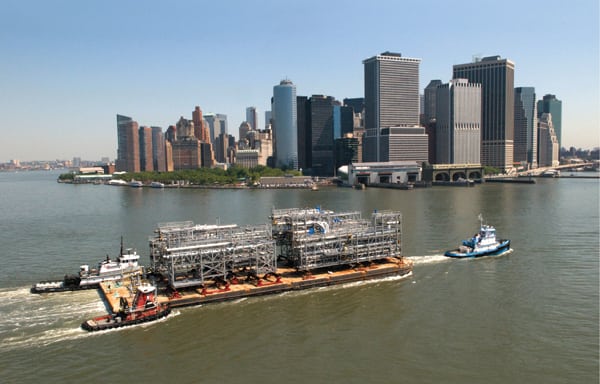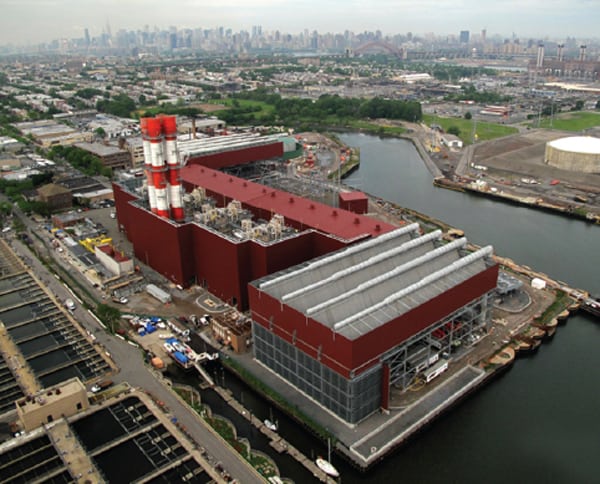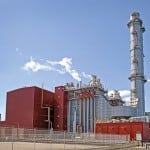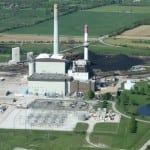 |
Owner/operator: Astoria Energy LLC
Managing construction of the 550-MW Astoria II Combined Cycle Plant in the midst of Queens, a densely packed New York City borough, required extensive off-site modular construction and a high level of logistical organization. Now the new Astoria II plant is operating successfully in conjunction with the Astoria Energy I plant as the largest natural gas–fired power plant in the Big Apple.
Queens, one of the five boroughs of New York City, is a tightly woven patchwork of diverse neighborhoods, industrial sites, and waterfront properties. When Astoria Energy LLC decided to move forward with the Astoria Energy II Expansion Project, the biggest challenge was carrying out a massive, complex construction project in the midst of one of the most densely populated areas in the U.S.
The 550-MW (575 MW, nominal) facility was constructed directly adjacent to the existing 550-MW Astoria Energy I Power Plant, which was commissioned in 2006 (Figure 1). Construction activities on the new plant could not interfere with operation of the existing plant or with maintaining the security requirements under the U.S. Coast Guard MARSEC Plan, explained Bob Maso, site manager of the Astoria II project.
The relatively small space where the new power plant was to be built and the lack of laydown area presented significant challenges. As a result, several major components—including the heat recovery steam generators (HRSGs), the pipe racks, and the air-cooled condenser—were assembled off-site and barged in (Figure 1).
 |
| 1. A tight fit. The compact size of the site required the engineering team to utilize nearly every square foot of space. The plant is built literally to the property lines on all sides. Courtesy: SNC-Lavalin |
Keeping track of the power plants located in Queens is made somewhat confusing due to the fact that a number of them use the word “Astoria” as part of their names. For example, the original Astoria Power Plant Units 1 through 5 were conventional steam units that burn gas and oil. Those units, developed by ConEd, are now owned by U.S. Power Generating. In addition, there is another project in the same geographical area called NYPA Astoria Project, which uses a variation of the same plant name, but it was developed by the New York Power Authority (see the August 2006 issue in our archives at https://www.powermag.com for a Top Plants story on that facility). Finally, the two new Astoria Units I and II, which are profiled in this article, are brand new gas-fired combined cycle plants located near the original Astoria plants.
Permitting Hurdles
The $1.3 billion Astoria II project was governed by an Article X Permit, which was granted by the New York State Public Service Commission to Astoria Energy LLC, the plant owner.
“This permit established strict guidelines for minimizing the impact of the project on the surrounding neighborhoods both during construction and operation,” Maso said. “These guidelines covered hours of operation, noise limits, traffic to and from the project, and environmental criteria. The environmental rules required removal from the site of all unused excavated material.”
The project was executed under a project labor agreement negotiated with the Greater New York City Building Trades Council. That agreement was negotiated with the union locals and included the understanding that offsite prefabrication of major components was the only way the project could be executed.
Overcoming Construction Challenges
The main power island for Astoria II was constructed on a seven-acre parcel of land fronting the Bowery Bay section of Long Island Sound on the north and a body of water known as Steinway Creek on the west. The compact size of the site required the engineering team from SNC-Lavalin Constructors Inc. to utilize nearly every square foot of space. The plant is built literally to the property lines on all sides.
In addition, a new 345-kV gas-insulated switchyard and control room had to be constructed at the Con Edison site across Steinway Creek from the main Astoria Energy site. This highly contaminated site posed a huge environmental challenge during the excavation phase, which included more than 1,000 feet of trenching to install two new underground feeders to tie into the existing 345-kV grid. Significant upgrades also had to be made at Con Ed switchyards in both Manhattan and Brooklyn.
Offsite modular construction had to be maximized in order to both meet the schedule and allow the plant to be erected on the limited footprint. The SNC-Lavalin project team constructed a new berthing dock to allow barges to dock at site. This was needed due to the deteriorated condition of the existing bulkhead, Maso pointed out.
The 275-foot-tall exhaust stacks were prefabricated by Alstom in the largest sections possible and delivered, along with the outlet duct work, to the Port of Newark. The units were unloaded and transported by barge to a staging area in New Jersey. The erection contractor mobilized crews to the staging area to install the platforms and ladders prior to the sections being brought to the site. Maso emphasized that “this minimized the amount of site erection time, which was critical to the execution plan.”
Two Alstom three-pressure HRSGs were fully assembled at a site near Tampico, Mexico. The units were engineered by Alstom specifically to be transported fully assembled. The level of completion included hydrostatic testing, instrumentation and electrical, insulation of drums and piping, and finish painting. The units were transported on separate barges to the Astoria II site. They were offloaded with multi-axle transporters and set on their waiting foundations.
A facility in Corpus Christi, Texas, assembled six piping utility modules to be installed at the Astoria II plant. They were loaded on a single 100-foot by 300-foot barge and towed to the Astoria II site. Delivery of these modules had to be timed with delivery of the HRSGs in order to be set at a predetermined point in the execution plan.
The main electrical room was completely assembled and tested at a facility in Houston, Texas, and was the largest unit of its kind ever manufactured by Powell Electric. It was towed by barge to the Astoria II site and required two 600-ton-capacity cranes to set it on its foundation. The Houston facility also manufactured four smaller electrical rooms.
The 12 cooling fan modules were assembled at a facility on the Hudson River near Coeymans, N.Y. These modules were delivered by barge to the Astoria II site and set in place by a massive Manitowoc 18000 Series crane.
“The overall coordination of shipping logistics and unloading of heavy equipment went off like clockwork, with the great effort that the team put into motion during the development of the execution plan and construction sequencing,” Maso said.
Environmental Issues
The Astoria II project actually consisted of two separate construction sites: the power plant itself and the 345-kV substation located across Steinway Creek. Each of these locations posed unique environmental challenges that were met with success due to the careful planning and expertise of the field staff, explained Rowena DeFato, manager of Sustainability/Environment at SNC-Lavalin.
The Astoria II power plant is located on property once used for bulk oil storage. This previous site use resulted in soil contamination by petroleum products. DeFato pointed out that the site construction and site environmental management plans were supplemented by various other specific plans needed for such a complex remediation site. These included a monitoring well protection plan, water management plan, soil management plan (including sampling protocols), and a noise control plan. In addition, the site was required under law to have a stormwater pollution prevention plan, a spill containment and countermeasure plan, and a facility response plan.
“The physical location of the construction site also required creative solutions to avoid adverse environmental impacts,” she said. “For example, the shallow groundwater did not allow for the usual concrete wash pit, so a service was found that would provide concrete wash bins that, once filled, were removed and replaced with empty containers. The project was also able to achieve an average 76% recycling rate.”
Successful Teamwork: Astoria I and Astoria II
Start-up and commissioning of the Astoria II facility was completed in June 2011. The Article X Permit had strict provisions for noise generated during steam blows that were met through the use of high-volume, low-velocity blow methods. The new, combined Astoria Energy II control room was fully integrated with the Astoria I plant during a scheduled outage early in the commissioning schedule.
“The facility achieved the commercial operation date on July 1, 2011 and is now operating in conjunction with the existing Astoria Energy I plant as the largest natural gas power plant in New York City,” Maso said.
— Angela Neville, JD, is POWER’s senior editor.










